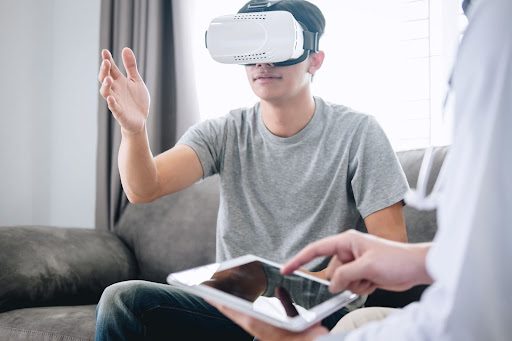Obsessive-compulsive disorder (OCD) is a chronic mental health disorder characterized by uncontrollable thoughts and urges to do repetitive behaviors. While many individuals respond to treatment, researchers continue to explore innovative options, such as virtual reality.
Virtual reality (VR) therapy for OCD may sound like something from a science fiction movie, but it has taken its place as a valuable mental health assessment and treatment tool. Virtual reality has been most widely used to treat trauma and anxiety, but its use with OCD is also increasing. And while there are concerns and uncertainties about OCD and virtual reality therapy, it also has the potential to improve outcomes, especially for those with specific symptom needs.
Read on to learn more about virtual reality therapy and its potential advantages as an assessment and treatment application. Then learn more about what virtual reality therapy for OCD may look like.

Virtual reality therapy (VRT) involves using technology to create realistic, immersive experiences for therapeutic benefit. Individuals can role-play and experience challenging situations in a safe, controlled setting. For example, VRT can be used to create customized virtual environments as a component of exposure therapy, a first-line treatment for anxiety disorders. With exposure therapy, feared stimuli are repeatedly shown to individuals, allowing them to develop habituation. Habituation is a decreased sensory response achieved by repeated stimulation and re-evaluation of the threat level. Over time, individuals reduce the connection between specific stimuli and their anxious reaction.
Virtual reality has several advantages as a therapeutic tool, offering a realistic and customizable experience. Virtual therapy is:
Virtual reality is used primarily for obsessive-compulsive disorder assessments. VR treatment is less necessary because OCD-specific stimuli are accessible to most individuals in their daily lives. However, VR could be beneficial for individuals with specific needs.
Virtual reality can be a helpful assessment tool for OCD due to its unique stimulating capabilities. Clinicians rely on self-report to determine an individual’s symptoms and how they arise. While this is a well-established method, self-reporting symptom frequency and duration may not be accurate. Virtual reality allows for exposure to distressing stimuli in real time, allowing the therapist to take objective measurements in a safe and supportive environment. One study validated the correlation between checking behaviors that were self-reported and measured in virtual reality environments. Because the virtual environment can be controlled and personalized, observations are more relevant than standardized assessments.
While there are many upsides to using virtual reality as an assessment tool, there are also a few potential disadvantages. First, virtual reality may not be suitable for some individuals, especially those prone to seizures, motion sickness, and eyestrain. Second, a study on virtual reality assessments indicated that individuals may not respond with compulsions in the VR environment as they would in natural settings. So even if virtual reality offers more specific symptom measurements, some factors may limit overall accuracy.
Computer-based treatments were the first innovative use of technology for treating OCD. Virtual reality also holds promise as a valuable technology-based treatment option, though it is not widely used for this purpose and needs more development.
Computer-Based Interventions
Before virtual reality, computer-based treatments became established as an effective therapeutic tool. Individuals in treatment used the earliest versions to track obsessions and compulsions between therapy sessions. Evidence suggested that computer-based OCD treatment was as effective as taking selective serotonin reuptake inhibitors (SSRIs), a type of antidepressant medication.
Virtual Reality Interventions
One obstacle to the broader use of VR treatments is a lack of research studies. Because feared stimuli often occur naturally in an individual’s environment, VR treatment may not be necessary for most individuals. However, one study showed that exposure and response therapy (ERP), a type of exposure therapy designed to address OCD symptoms, may be valuable in virtual reality format.
ERP addresses two foundational elements of OCD, anticipatory fear and avoidance of feared stimuli. Individuals link distressing experiences with feared stimuli, and they learn to avoid the stimuli to prevent anxiety. This cycle reinforces their anxiety and strengthens both their obsessions and compulsions. ERP addresses these by introducing exposure to feared stimuli without engagement in rituals and avoidance. This approach encourages individuals to tolerate anxiety and challenge their perceptions of feared stimuli.
Though most feared stimuli for individuals with OCD are present in their natural environment, virtual reality may still be beneficial by providing more precise and consistent exposure.
The future of virtual reality in mental health shows significant potential, including the assessment and treatment of OCD. Despite having a relatively small body of literature, new studies continue to build a foundation of knowledge. With every new study, such as one exploring emotional responses and contamination OCD, much is learned about how individuals interact with their environment.
Studies that broadly evaluate the efficacy of virtual reality treatments are needed to see progress. Currently, not enough is known about which characteristics of virtual reality are most effective at provoking targeted emotional responses. As studies reveal the most effective aspects of virtual reality with OCD, future applications can take a more targeted approach toward specific symptoms. Among those who have used virtual reality treatments for OCD symptoms, many have had positive experiences, indicating that VR treatments of the future may be well-received on a larger scale.

Innovative technological treatments are becoming more common in mental health. Computer-based treatments and transcranial magnetic therapy (TMS) are two such research-backed therapies for OCD. Virtual reality has become more commonplace as an assessment tool for OCD, and future research may set the stage for its growth as a treatment approach. Virtual reality continues to push boundaries, helping individuals better understand and live with OCD.